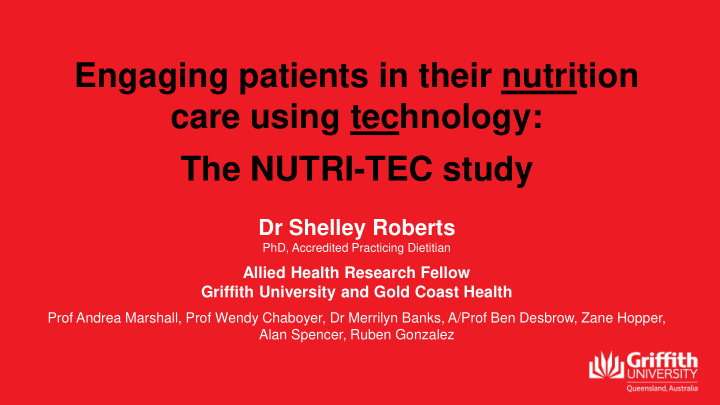



Engaging patients in their nutrition care using technology: The NUTRI-TEC study Dr Shelley Roberts PhD, Accredited Practicing Dietitian Allied Health Research Fellow Griffith University and Gold Coast Health Prof Andrea Marshall, Prof Wendy Chaboyer, Dr Merrilyn Banks, A/Prof Ben Desbrow, Zane Hopper, Alan Spencer, Ruben Gonzalez
Background: Hospital Malnutrition • Malnutrition affects 20 – 50% of hospitalised patients 1,2 • Serious consequences for: » Patients: ↑mortality, complications (infection, pressure injury, falls) 3-5 » Hospitals: ↑LOS, readmissions, hospital costs 6,7 • Inadequate dietary intake major modifiable risk factor » Majority of patients fail to meet nutrition needs in hospital 8,9 » Interventions to improve dietary intake are needed Patient participation in care can improve dietary intakes in hospital 10,11
Background: Patient Participation in Care • Core concepts of patient participation in care: 12 » Meaningful exchange of knowledge/information between patient and clinician » Mutual engagement in health care activities & decisions » Surrendering of some power/control by clinicians • Australian Commission on Safety and Quality in Health Care national standard 13 • Improves patient outcomes, satisfaction, safety 14,15 • Improves nutritional intake among hospitalised patients 10,11
Overall aim Use an integrated knowledge translation approach to develop, evaluate and implement a patient-centred intervention to engage patients in their nutrition care, for improving their dietary intakes in hospital.
Foundational research (PhD) Literature review Hospital malnutrition: prevalence, causes, effects, interventions (incl. patient participation) Dietary intakes of hospitalised patients and Observational study nutrition care practices (in study context) 16,17 Patients’ perceptions of actively participating in Interviews their nutrition care 18 Theory and data informed (self-efficacy, patient Intervention design participation in care, self-monitoring, goal setting) Determining feasibility, acceptability, indication of Pilot intervention effectiveness (paper materials) 11
Paper-based intervention FINDINGS Feasible Patient education Likely to be effective Acceptable Self-monitoring (and feedback) Goal-setting
The next phase Using technology To engage patients in their nutrition care
Adapting intervention to new technology
KNOWLEDGE TO ACTION (K2A) FRAMEWORK Graham, Ian D., et al. "Lost in knowledge translation: time for a map?." Journal of continuing education in the health professions 26.1 (2006): 13-24.
Adapting intervention to technology: the NUTRI-TEC Study Literature review Realist review: Using technology to engage USABILITY TESTING & PATIENT INTERVIEWS (n=32) REALIST REVIEW hospitalised patients in their care 19 STAFF INTERVIEWS (n=19) 1. Familiarity with technology not necessary, but improves confidence 5 main features of successful Usability testing “I’m not any good with a computer because I haven’t even got one, but if I can navigate my way 1. Usability: user interface design and functionality 20 Enacting patient participation in practice through that then anyone can.” (P18, age 66) interventions engaging hospitalised (patients); and 2. “…the existing food chart is filled by nurses and sometimes we get patients User interface design significantly impacts usability (wording, display, navigation, instructions) “It wasn’t difficult, it was just frustrating…. It’s the way it’s set involved as part of helping them to become good self-managers, involved in patients in their care: out…. It seemed to confuse me having all those little boxes in one lot.” (P11, age 63) completing their food chart.” (Dietitian) 3. Identifying benefits to technology increases its acceptance (efficiency, Patient and staff perceptions of using this 2. Optimising nutrition care Interviews (patients flexibility, individualised) “The best thing about it, it’s instantaneous, you can’t lose the 1. Information sharing piece of paper…and the order goes straight to the kitchen…it’s very easy to do.” (P9, age 61) “It would be a lot easier to look at that [intake tracking] than a food chart. Also, technology to participate in nutrition care 20,21 4. Technology enables participation, which occurs to varying extents and staff) obviously nurses are very busy, so if the patient is just doing it themselves 2. Self-assessment and feedback (information access, communicating with staff, personal factors) then that might be a better prospect.” (Doctor) “If patients knew exactly what was in the meals and what they were ordering exactly then they’d maybe make different decisions of what they were going to order in the first place.” (P14, age 32) 3. Tailored education 3. Co-development with end-users (staff, patients) and Considerations for implementing the program in practice 5. Degree of participation depends on perceived importance of nutrition “I would say there definitely would be a percentage [of patients] that would find Intervention design industry partner (Delegate Technology) 4. User-centred design (personal interest/relevance, level of control / responsibility of nutrition it difficult to fill them in. But I think the nursing staff could certainly assist in in hospital) “I’m just not that interested in those specifics…In fact thinking about it, my wife those cases if we are already filling in a food chart anyway.” (Nurse) would find real interest in that. She’s really interested in those sorts of things – I’m not, because 5. Support in the use of technology she looks after me.” (P24, age 63) Determining feasibility, acceptability, indication of Pilot intervention effectiveness (tech-based)
Next steps • Analyse pilot study data • ?Further feasibility work needed • Full scale trial • Effectiveness (improving nutrition intakes, reducing malnutrition-related adverse events) • Patient engagement, satisfaction/acceptability • Cost-effectiveness • Long term implement into usual practice
Recommend
More recommend